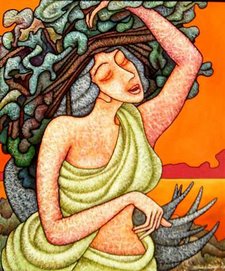 As per our guide, many theories about the first builder of the Citadel. Given its location, on a high hill, its advantages as a defensive location are obvious.
As per our guide, many theories about the first builder of the Citadel. Given its location, on a high hill, its advantages as a defensive location are obvious.One of the first builders of the citadel is reputed to be Seleucius Necator, a Greek king and a general in Alexander the Great's army. Others believe an even earlier construction of the Citadel construction given the discovery of Hittite temple built during the second and first millennia BC. Still others talk about Sayf al-Dawla (944-967), the first Hamdanid ruler of Aleppo, having built the fortress and used the citadel as a military center of power over his region, but the present structure and design of the Aleppo citadel is supposed to be the work of Ghazi - Salauddin's son.
The sole entrance to the Citadel is through an outer tower. There are three gates with carved figures at each. In the court there is a cistern (Byzantine) and a few brick vaults, probably dungeons. The pitch dark of the inside of the gateway is to strengthen the contrast between light and dark so that it would be impossible for attackers to see.
As you walk inside the Citadel, you notice that all pathways slope downwards which were to allow rain water to flow down to the water cisterns. The guide took us to se the underground water cisterns - supposedly, the fort could remain sealed w/o water for a period of 1 year given the water storage system. You can see the walls of the cistern which have been eroded over the years by the water, and, smell the damp..there are also two large storage rooms for harvested crops..
The Citadel has its own huge amphitheatre.
 Over the years, the citadel evolved into a city that included functions ranging from residential (palaces and baths), religious (mosque and shrines), military installations (arsenal, training ground defense towers and the entrance block) and supporting elements (water cisterns and granaries).
Over the years, the citadel evolved into a city that included functions ranging from residential (palaces and baths), religious (mosque and shrines), military installations (arsenal, training ground defense towers and the entrance block) and supporting elements (water cisterns and granaries).
Just opposite the entrance of the Citadel are a number of street side cafes which only accept local currency. There is no money changer around, so be sure to carry some local currency in case you want to sit down, order a coffee or a tamarhind juice and enjoy the view of the Citadel.
A little furthur down is a massive construction being undertaken. Our guide very helpfully told us that this was a new 5 star construction which was due to be completed next year. Then you can stay right at the foot of the Citadel and watch it from you window every night. Till then, unfortunately, you'll have to live with the less exciting view of the city!




No comments:
Post a Comment